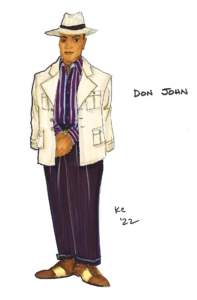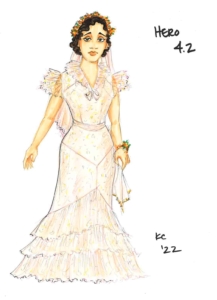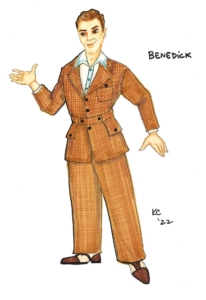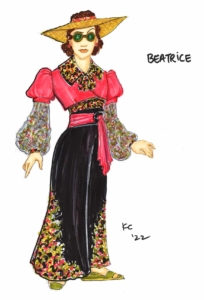DCPA NEWS CENTER
Enjoy the best stories and perspectives from the theatre world today.
Enjoy the best stories and perspectives from the theatre world today.

Costume rendering of Don John in Much Ado About Nothing by Kevin Copenhaver
If clothes make the man, does it stand to reason that costumes make the villain? That’s the question we posed to DCPA Costume Crafts Director Kevin Copenhaver, who has been tasked with designing 1930s-era costumes for Much Ado About Nothing.
Not necessarily, was his answer. “I don’t think costumes make the hero or the villain. I think that’s the character and the actor portraying the character,” Copenhaver explained. “I think the costumes can enhance if the character is a ‘villain’ or ‘hero.’”
When looking at the conventions that have been used in film, television, and theatre to portray “good vs. evil,” color has often been used to elicit an emotional response.
“In Shakespeare, color plays a big role for me,” he said, “…because when you have 37 named characters and the audience has to follow who’s who, I often will use color as a way of identifying a character for a through line.”

Costume rendering of Hero in Much Ado About Nothing by Kevin Copenhaver
“If time and budget allow and we build multiple costumes for a particular character, I will often create a palette for them and keep that palette throughout the course of the play — so you can identify that character by color.” But it’s easy to overuse that convention, so Copenhaver takes a more sophisticated approach when considering the fabric texture and silhouette of each character’s attire.
Take, for instance, the villainous character of Don John in Much Ado About Nothing. “I put him in some ‘slippery’ textures, certainly his trousers,” he described. “They have a shine to them that nobody else in the show is wearing. So I feel like texture plays a big role for me when choosing fabrics for those types of characters.”
On the other hand, Hero is “young and sort of naïve, so I’ve chosen a whimsical pattern for her first outfit.… When she changes into her wedding attire, I would say that’s where the ‘hero’ comes in. It’s different shades of gold and a little bit of metallic in the lace. To me, it has a heroic quality.”

Costume rendering of Benedick in Much Ado About Nothing by Kevin Copenhaver
When Copenhaver and Director Chris Coleman sat down to envision the costume needs of the play, time, budget, and capacity all factored in. As a non-profit organization, budget considerations often influence the design of a show, and this production was no exception. “Chris and I had to come to a decision early on that there are certain characters that have to change clothes. Hero and Beatrice have to change, but for the other characters, we’re just going to go with a sort-of Shakespearean one costume [method] to tell the story.”
While Copenhaver initially designed costumes for every character, not all of them were ultimately built from scratch. Instead, approximately 50% of what audiences will see on stage are costumes and costume pieces that were pulled from the DCPA’s inventory. But there was one gap — WWII-era civilian menswear. “Oftentimes with Much Ado, the men will be in military clothing throughout the show, and that’s fine, but I find it kind of boring. We’ve thought of these gentlemen as being on leave for a month, so they are wearing their civilian clothes. Claudio, Benedict, and Don Pedro are not in uniforms the entire show.”

Costume rendering of Beatrice in Much Ado About Nothing by Kevin Copenhaver
Instead, Copenhaver looked to photos of the period for inspiration, including images from a treasure trove of books that fill his office. “I said they are wearing civilian clothes, but they are military-inspired civilian clothes,” Copenhaver described. “And luckily in the ’30s, a lot of the menswear was kind of quirky in that respect. A suit jacket, as we think of it now, might be belted and have pockets that you might find on cargo pants or bush jackets…sort of utilitarian.” Take that look, make it from certain fabrics with the right silhouette, and you have military-inspired civilian streetwear.
“I especially like to design period clothes, whether it’s the Renaissance or 1930s,” he added. “It’s great fun!”
DETAILS
Much Ado About Nothing
Sep 30 – Nov 6 • Kilstrom Theatre
Tickets
